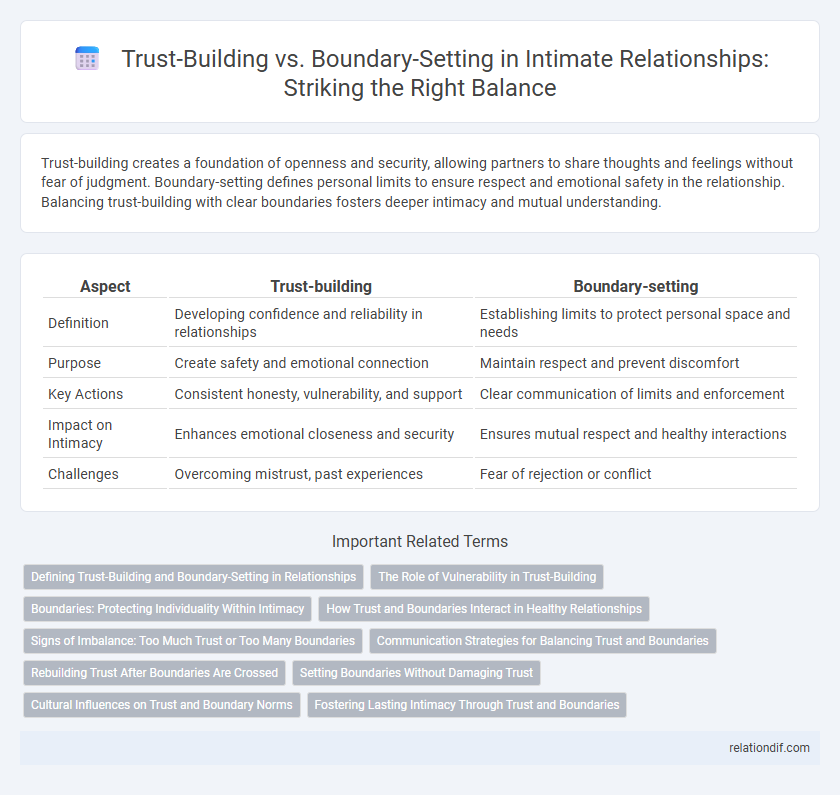Trust-building creates a foundation of openness and security, allowing partners to share thoughts and feelings without fear of judgment. Boundary-setting defines personal limits to ensure respect and emotional safety in the relationship. Balancing trust-building with clear boundaries fosters deeper intimacy and mutual understanding.
Table of Comparison
| Aspect | Trust-building | Boundary-setting |
|---|---|---|
| Definition | Developing confidence and reliability in relationships | Establishing limits to protect personal space and needs |
| Purpose | Create safety and emotional connection | Maintain respect and prevent discomfort |
| Key Actions | Consistent honesty, vulnerability, and support | Clear communication of limits and enforcement |
| Impact on Intimacy | Enhances emotional closeness and security | Ensures mutual respect and healthy interactions |
| Challenges | Overcoming mistrust, past experiences | Fear of rejection or conflict |
Defining Trust-Building and Boundary-Setting in Relationships
Trust-building in relationships involves consistent honesty, reliability, and emotional openness that foster a sense of safety and mutual respect between partners. Boundary-setting defines clear personal limits regarding emotional, physical, and communicative aspects to protect individual well-being while maintaining connection. Both processes are essential for creating healthy intimacy by balancing vulnerability with self-care and respect.
The Role of Vulnerability in Trust-Building
Vulnerability plays a crucial role in trust-building by allowing individuals to openly share fears, hopes, and insecurities, creating emotional intimacy. This level of openness fosters mutual understanding and strengthens relational bonds, setting a foundation for deeper connection. Trust is reinforced as both parties demonstrate honesty and empathy, which encourages ongoing vulnerability without fear of judgment.
Boundaries: Protecting Individuality Within Intimacy
Boundaries play a crucial role in intimacy by preserving individuality and ensuring mutual respect between partners. Setting clear limits helps prevent emotional enmeshment and fosters healthy communication, allowing each person to maintain their identity while deepening connection. Effective boundary-setting creates a safe space where trust can flourish without compromising personal autonomy.
How Trust and Boundaries Interact in Healthy Relationships
Trust-building and boundary-setting interact in healthy relationships by creating a foundation of mutual respect and safety where individuals feel secure to express themselves openly. Clear boundaries establish personal limits that prevent misunderstandings and foster consistent trust, while trust encourages vulnerability and honest communication within those limits. This dynamic balance enhances emotional intimacy and supports long-term relationship stability.
Signs of Imbalance: Too Much Trust or Too Many Boundaries
Excessive trust in intimacy can lead to vulnerability without protection, resulting in emotional exploitation or disappointment, while overly rigid boundaries may create distance, hindering genuine connection and communication. Indicators of imbalance include frequent feelings of betrayal despite no clear cause or persistent isolation and emotional guardedness. Healthy intimacy requires a dynamic equilibrium where trust is earned, and boundaries are respected to foster safety and openness.
Communication Strategies for Balancing Trust and Boundaries
Effective communication strategies for balancing trust and boundaries in intimacy involve clear, honest dialogue about personal limits and expectations. Active listening and empathetic responses foster mutual understanding, allowing partners to express vulnerabilities while respecting individual needs. Consistent check-ins create a safe space for renegotiating boundaries, reinforcing trust and emotional connection.
Rebuilding Trust After Boundaries Are Crossed
Rebuilding trust after boundaries are crossed requires consistent transparency and open communication to demonstrate respect and accountability. Establishing clear, mutually agreed-upon boundaries reinforces emotional safety and helps repair the relationship's foundation. Therapeutic interventions, such as couples counseling, can facilitate understanding and guide partners through the trust restoration process effectively.
Setting Boundaries Without Damaging Trust
Setting boundaries in intimate relationships involves clear and respectful communication that honors personal needs without creating emotional distance. Trust remains intact when partners openly discuss limits and validate each other's feelings, fostering mutual understanding. Consistent boundary-setting reinforces safety and respect, which are foundational to deepening trust.
Cultural Influences on Trust and Boundary Norms
Cultural influences significantly shape trust-building and boundary-setting practices, with collectivist societies prioritizing group harmony and indirect communication, often leading to implicit trust and flexible boundaries. In contrast, individualistic cultures typically emphasize explicit agreements and clear personal boundaries, fostering trust through direct dialogue and clearly defined limits. Understanding these cultural norms is essential for navigating intimacy effectively across diverse social contexts.
Fostering Lasting Intimacy Through Trust and Boundaries
Fostering lasting intimacy requires a delicate balance between trust-building and boundary-setting, where open communication and consistent reliability cultivate a safe emotional environment. Establishing clear personal boundaries respects individual needs while reinforcing mutual respect, creating a foundation for deeper connection. Prioritizing both elements enhances vulnerability and strengthens the emotional bond essential for enduring intimate relationships.
Trust-building vs boundary-setting Infographic

 relationdif.com
relationdif.com